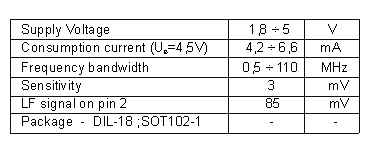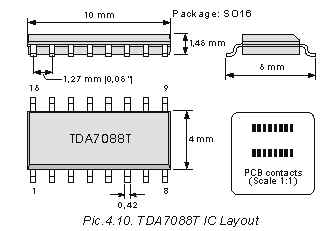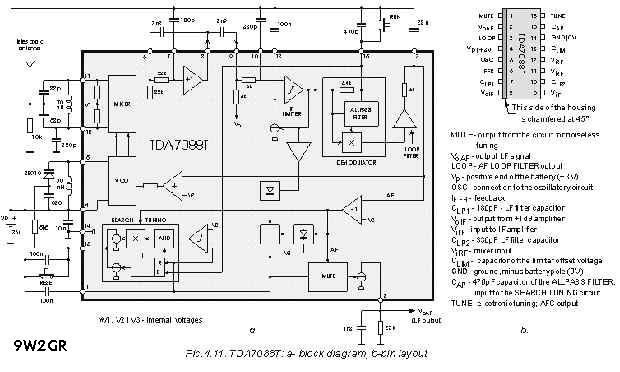

The receiver described in the last project has two IC's, one variable capacitor, two small coils and fairly small few other components, so it can be put into some small box, by carefully placing the components. Further miniaturization can be accomplished by using the SMD components. These are the resistors, capacitors, transistors, IC's and other components, whose dimensions are significantly smaller than these of "classical" components. They are mounted on the copper side of the PCB, therefore it isn't necessary to drill the holes on the board. TDA7088T is also an SMD component. Its drawing is shown on Pic.4.10. This IC is the successor of the famous TDA7000, i.e. it is an improved model of TDA7000, that allows to implement both monophonic and stereophonic FM receiver. The basic features of TDA7088T are given in the following table.


The electronic diagram of the HF part of the
monophonic FM receiver made with TDA7088T IC is given on
Pic.4.11. The IC contains all the parts of the classic
superheterodyne receiver: the local oscillator, IF amplifier and
FM detector, but also some other circuits that extend the
possibilities and improve the features of this IC. As far as
practical use is concerned, the most significant novelty is the
auto-tuning circuitry. No variable capacitor is necessary for
tuning, as it was in all the previous projects, the BB910 varicap
diode is used instead. Its capacitance is being changed by
varying the DC voltage supplied to its anode over the 5k6
resistor. This is how the tuning is performed: When the user
press and releases the pushbutton marked with "RUN",
the positive voltage impulse is released to the S(et) input of
the SEARCH TUNING circuit. The 100 nF capacitor then starts
chargingl and the voltage on the pin 16 increases. This voltage
is then transferred, over the 5k6, to the anode of the BB910,
causing its capacitance to decrease, which increases the
frequency of the local oscillator (VCO). The VCO voltage is led
into the mixer (MIXER) which also receives, over pin 11, the
signals of all the other FM stations. The mixer outputs the FM
signals whose frequencies are equal to the differences of the
oscillator and the original station frequency. The only signal
that can reach the demodulator (FM detector) is the one whose
carrier frequency is equal to the inter-frequency, i.e. fm=73 kHz
(selectivity is being accomplished by two active filters whose
components are the capacitors connected to pins 6, 7, 8, 9 and
10). Therefore, the oscillator frequency increases until it gets
the condition fO-fS=73 kHz is accomplished. When this happens,
the charging of the capacitor is halted by the command that is
sent into the SEARCH TUNING circuit by two detectors
(diode-blocks) located in the MUTE circuit. The AFC (Automatic
Frequency Control) circuit now gets its role and prevents the
voltage on pin 16 to be changed, until the RUN button is pushed
again (this voltage can vary from 0 V til 1.8 V during the
tuning). When the RESET button is pushed, the 100 nF capacitor is
discharged, the voltage on pin 16 drops down to zero, and the
receiver is set to the low end of the reception bandwidth, i.e.
88 MHz. Let us get back to the mixer. On its output, the 73 kHz
FM signal is obtained, and it is modulated by the programme of
the first station that is found after the RUN button is pushed.
This signal then passes the active filters, gets amplified in the
IF amplifier (IF LIMITER) and passed onto the input of the
demodulator. By connecting the demodulator exit, over the LOOP
FILTER, the adder (+) and resistor, to the VCO, the so-called FFL
(Frequency Feedback Loop) circuit is accomplished, reducing the
deviations of the signal being received from ±75 kHz to ±15
kHz. The LF (AF) signal is led from the demodulator, over the
LOOP FILTER stage, the invertor (-1) and MUTE circuit onto the
pin 2. The detectors (diode-blocks) control the operation of the
MUTE circuit, preventing the LF (AF) signal to reach the output
pin (2) until the tuning on the station that creates the signal
in the antenna that is strong enough for quality reception is
obtained. 
[ Homebrew ] [ Homepage Utama ]